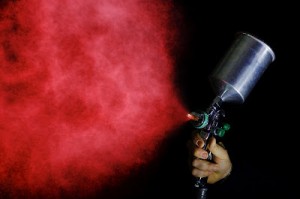That’s why, if you have a choice between spraying or air brushing and using a paint brush, your safer choice is the brush. Anytime you atomize a liquid, you produce a mist of a million microscopic particles, which can float in the air that you breathe for hours.
If you are spray painting or air brushing you need good ventilation to rid the air to the vapor. Even if you are spraying a water-borne paint, such as Createx Auto Air, you should at least wear a good-quality, multi-ply dust mask. When spraying enamels, you should be wear a chemical respirator, safety glasses and latex painters gloves. Working with urethanes requires additional equipment.
When you are either spray painting or airbrushing a solvent-based paint, carefully read and follow the safety precautions on the labels. Air respirators, latex gloves and goggles may not look too cool, but they are necessary. Good ventilation is critical because it expels fumes that are not only toxic, but also flammable.
If you are spraying enamel paint or working with adhesive removers, at the very least, you need to wear a half-face cartridge-type respirator, which you can buy for less than $75. A full-face respirator, which has a plastic face shield to provide eye protection, will cost about $150. Both types of respirators have two replaceable cartridges that will filter out harmful vapors.
Be aware that these cartridges are only effective for a limited amount of time. Generally, after forty hours of use, you will need to replace the canisters. An indication that the cartridges have soaked up all the bad fumes that they are capable of filtering is when you start to smell solvents. A pack of two replacement cartridges costs between $12 and $15. To extend the life of the filters, remove the cartridges when you are not using the respirator, and store them in a plastic zip-lock storage bag.
The air-purifying, cartridge-type of respirator is not suitable for spraying urethane paints, which have isocyanates in them. When spraying urethane, you will need the type of respirator that supplies the user with fresh air.
Isocyanates. Urethane paints contain isocyanates, which are one of the raw materials used in making the hardener. Exposure to isocyanates can cause a variety of health problems, such as bronchial irritation and occupational asthma, skin irritations (rashes and blisters), and eye irritation and damage of the cornea. Isocyanates are also thought to be carcinogenic.
Because isocyanates are dangerous compounds, their safe use is imperative. Isocyanates readily attaches to the moist tissues of body, such as your eyes and the lining of your lungs. If you plan to spray urethanes, you need to use the safety equipment designed to protect your respiratory system, eyes and skin. You also need to train your employees about the health hazards associated with isocyanates and make sure that they wear the appropriate safety equipment.
Several different types of breathing equipment are available on the market. When spray painting, your body should be completely protected from head to toe. In addition to a chemical mask or other type of respiratory/breathing system, you should wear rubber gloves, coveralls, a hood to protect you hair and a face shield. When using urethanes, spraying should be done in a commercial paint booth and the painter should use a fresh air respirator. Ventilation equipment with special compressors provide are generally required. A compressor and hood can easily cost $700 or more.
Precautions. If your employees are exposed to hazardous fumes, you must take the following steps:
- If your employees are exposed to hazardous fumes, you are required by law to inform your employees of the dangers to which they are exposed. You must also instruct them on when and how to use respirators and other safety equipment. Communicate this information verbally and then put it in writing.
- Whenever you work with solvents and paint, make sure that you and your employees wear the appropriate safety equipment, such as dust masks, safety glasses, gloves, protective clothing and breathing equipment. You must instruct employees on how to maintain any safety equipment that they would use.
- Whenever you are using solvents or other harmful chemicals, you should work in a well-ventilated area. Good ventilation doesn’t mean running a fan to move the vapors from one part of the shop to another. Mixing up the air is not a solution. If you are exposed to a high degree of harmful fumes, your shop may need a ventilation system.
- A good ventilation system should move the solvent vapors from your work area to the outside and draw fresh air into the room. When you are working with solvents, make sure the ventilation system is turned on.
- Any employees, who are required to wear respirators, must take a pre-employment physical to discover, if he or she has any pre-existing conditions, which could cause medical complications. Regular physical exams should be encouraged for all employees of your company.



